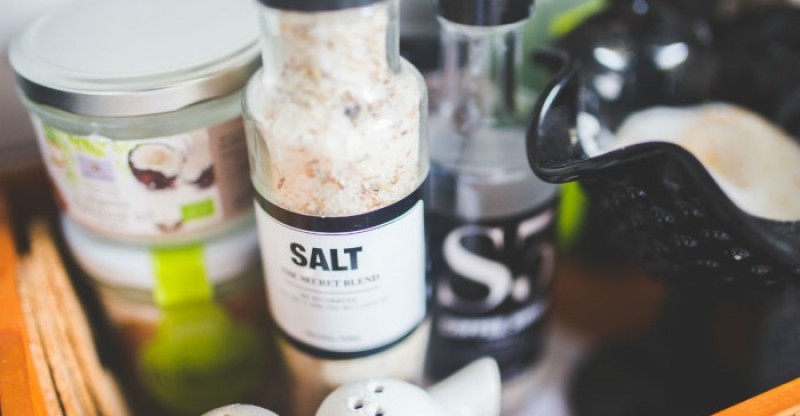How Much Sodium Should You Have Per Day?
Sodium is one of those nutrients that people misunderstand in their diet.
Doctors often tell them that they are overeating sodium and jeopardizing their health.
However, the same doctors may also lecture them if they cut out too much sodium and end up with what is termed a serious deficit in their dietary sodium intake.
That’s why we’re here to help you.
This article has been carefully researched and fact-checked to ensure that you get only the most accurate information.
With its help, you can balance your intake of sodium healthily and beneficially.
So please make sure to read this carefully, and to take the tips offered here very seriously.
Recommended Daily Doses of Sodium
When asking yourself how much sodium per day is healthy, it is important to know that many different sources suggest varying levels of sodium.
It is also important to remember that salt, while high in sodium, isn’t 100 percent sodium.
As a result, it is possible to eat more salt than sodium without suffering from any major problem.
However, it is important to understand the different sodium levels suggested by health officials and to consider your personal needs before taking their recommendations.
We’ll touch briefly on these recommendations to give you an insight into what they mean, and help you decide which level is right for your personal needs.
The US Department of Agriculture
This organization states that a healthy level of sodium is about 2,300 milligrams or so (1).
They suggest this amount because anything above it is dangerous to the heart and could cause a serious risk of cardiac danger.
However, they also believe that going below this level could be hazardous to some people.
American Heart Association
This heart health group has a much stricter regulation of sodium intake.
They suggest a person limits themselves to 1,500 milligrams of sodium every day (2).
They believe that any more than this will seriously affect the heart and cause severe health concerns for people.
Academy of Nutrition and Dietetics
Like the American Diabetes Association, this group suggests a person ingest a sodium intake of about 1,500 to 2,300 milligrams (3).
This wider range is because some people may need higher levels of sodium than others.
For an understanding of this amount, 1,500 milligrams of sodium is about three-quarters of a teaspoon, while 2,300 milligrams of sodium is a full teaspoon.
Deciding on a Sodium Intake Level
The trickiest aspect of this process is gauging your sodium intake per day.
The recommended sodium intake is likely to differ wildly for most people.
Another common concern is how much salt do you need to reach that level of sodium.
While we briefly touched on that amount above as a way of effectively visualizing it, for most people it can be hard to gauge your total sodium intake throughout the day.
The Complications of Calculating Sodium Intake
While we already discussed that salt intake is slightly higher than sodium intake, it is important to understand just how big this difference is before gauging your sodium intake.
As table salt is about 40 percent sodium, this will influence your intake of sodium slightly (4).
Even trickier, it can be hard to guess how much sodium is in most types of food.
For example, most food produced for the supermarket will have added levels of sodium that help preserve it and add to its taste.
So somebody adding salt to this processed food (such as salting French fries) is just adding an even higher level of sodium to food that is already rich in it.
Make sure to talk to your doctor before adjusting your sodium intake too much.
Wildly changing your diet without help is always a bad idea, because it can cause your body to react sharply and in a negative way.
For example, it can cause the heart to suffer from problematic side effects, and may even precipitate a heart attack.
Why Too Much Sodium is Bad
Sodium is an essential nutrient that does benefit your body in a lot of ways.
For example, it helps improve the operation of your nervous system.
However, how much sodium is too much? That is a tricky question to answer.
Too much can cause serious problems.
The biggest problem posed by an excess of sodium is that it contributes to heart problems.
There are many different types of heart problems that are caused by overeating sodium, and they typically grow worse over an extended period.
Now, we’re going to take a look into some of the dangers that excessive sodium in the body can cause.
We will briefly touch on each of these dangers, and give you an example of why excessive sodium is such a serious concern.
Sodium Affects Blood Pressure
One of the biggest problems that occur when you overeat sodium is an increase in your blood pressure.
Blood pressure is strongly linked to serious heart problems, such as heart attacks and strokes.
The reasons for this increase are somewhat complicated.
However, they have been tested and noted multiple times, making it crucial to avoid eating too much sodium.
For example, people who have very salt-heavy diets have been shown to suffer from heart attacks at a much higher rate than those who eat a balanced intake of sodium (5).
Even worse, their heart attacks tend to be more severe and debilitating than those who did not eat high levels of sodium.
This problem is a primary reason that heart health groups recommended much lower levels of sodium than other groups.
Stroke Risk is Also Increased
Another common problem that occurs when a person eats too much sodium is an increased risk of stroke.
As sodium flows in the blood, an excess amount can cause the blood vessels in the body to constrict and even completely close up.
When this process occurs too heavily in the blood vessels of the brain, a stroke will occur and cause severe brain damage if it isn’t carefully managed (6).
Decreasing your intake of sodium is an excellent way of helping to manage this problem constructively.
However, that doesn’t mean that a person automatically reduces their risk of heart attacks by lowering their sodium intake.
Dietary changes must be paired with exercise and heart health management methods to ensure it doesn’t become a more serious problem.
Why Too Little Sodium is Bad
Another problem that those trying to manage their sodium intake may run into is ingesting too little sodium.
As mentioned above, the recommended rate is about 1,500-2,300 milligrams a day.
However, when figuring how much sodium per day is healthy for you, it is important that your sodium intake per day doesn’t drop below 1,500 milligrams.
That’s because several severe dangers could occur that may be worse than overeating sodium.
That’s why it is important to know how going below your recommended sodium intake in a day will cause your body to react in surprising ways.
Again, make sure to talk to your doctor before making any significant dietary changes.
They can help answer how much salt you need, and keep you on the right track for proper sodium intake.
Too Little Sodium Hurts Your Heart
Ironically, researchers have found that low sodium intake can cause severe problems with the heart.
In fact, their findings noted that people who ate more than seven grams of sodium in a day did little to increase their heart health risk.
However, those who ingested less than three grams per day increased their risk by 26 percent.
The base comparison for this study was five grams per day, a healthy level (7).
This increase in heart health risk occurred because too little sodium also causes blood pressure to increase.
The body needs sodium to operate healthily and efficiently.
Without a healthy balance of it in the body, it is more likely to suffer from heart damage.
Other Problems Caused By Low Sodium Intake
There are even more problems associated with low sodium intake than high sodium intake.
For example, low sodium intake has been found to cause:
- Insulin resistance
- Higher unhealthy cholesterol
- Higher triglycerides
- Worsened risk for diabetes
- Dangerous risk of hyponatremia, or low levels of sodium in the blood
All of these problems are associated with a variety of severe health problems.
For example, hyponatremia can cause a person’s nervous system to malfunction or operate improperly.
Even worse, the risk of death from these complications is even higher with low sodium levels than it is at higher levels (8).
Decreasing Your Sodium Intake
There are several steps a person can take if they are worried about how much sodium is too much in their diet.
The first of these steps is to prepare all of your food on your own, such as cooking all your meat and making sauces.
During this process, limit the amount of salt that you add to each recipe.
In this way, you can carefully control the sodium you take in every day.
It is also possible to shop for low-sodium alternatives when processed food is necessary.
These may not eliminate the high level of sodium in the product, but do decrease the excessive amount.
Make sure to limit your helpings based on the amount of sodium in each.
In this way, it is possible to avoid overdosing on sodium (9).
Water is Essential
One surprising way that you can eliminate excess sodium from your diet is to drink extra water.
Water naturally flushes your body of sodium and restores it to a healthy level.
While a few extra glasses of water won’t eliminate all of the excessive sodium that may be in your diet, it can go a long way towards helping you manage an excess.
Adding More Sodium to Your Diet
If you are one of those people who eat too little sodium, it is vital to take steps to add more to your diet right away.
The best way to do that is to add various foods to your diet.
In fact, many foods are rich in sodium, and also healthy to eat.
Below, we will list some of these items and include the sodium count in each:
- Beets – 65 milligrams per beet
- Celery – 50 milligrams per large stalk
- Carrots – 50 milligrams per large carrot
- Beef – 75 milligrams per serving
- Lamb chop – 65 milligrams per serving
- Spinach – 125 milligrams per cup
- Chard – 300 milligrams per cup
These healthy foods are relatively easy to add to a diet and typically go well with a wide range of dishes.
For example, beets are an excellent side dish for just about any type of meat.
Make sure not to overdo it by eating varieties of these foods with sodium levels that are too high.
Vegetable Drinks Can Also Help
If you have a hard time adding these foods to your diet or just don’t enjoy veggies, try a shot of a vegetable drink.
These types of drinks, such as V8, are typically very high in sodium.
For example, one cup of vegetable juice has about 500 milligrams of sodium.
While you should try to get your sodium by eating these foods in their whole form, getting your sodium in this way is better than not getting any at all (12).
Conclusion
Hopefully, this article cleared up most of your confusion about the proper levels of sodium you should eat every day.
By following these guidelines and carefully balancing your sodium levels, you shouldn’t suffer from the serious health concerns a sodium imbalance causes.
However, you should also sit down with your doctor to discuss this process to ensure that you are doing everything properly.
Skilled medical professionals can help create a plan that works for your unique needs and which streamlines your diet.
They may also be able to prescribe sodium supplements for you.
FDA Compliance
The information on this website has not been evaluated by the Food & Drug Administration or any other medical body. We do not aim to diagnose, treat, cure or prevent any illness or disease. Information is shared for educational purposes only. You must consult your doctor before acting on any content on this website, especially if you are pregnant, nursing, taking medication, or have a medical condition.
HOW WOULD YOU RATE THIS ARTICLE?






